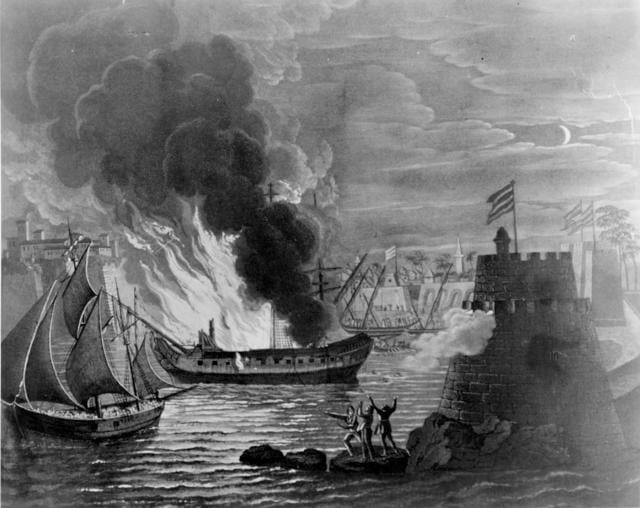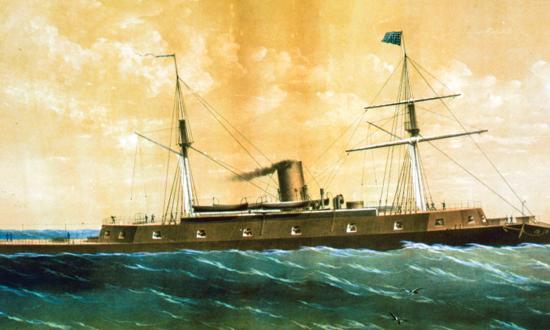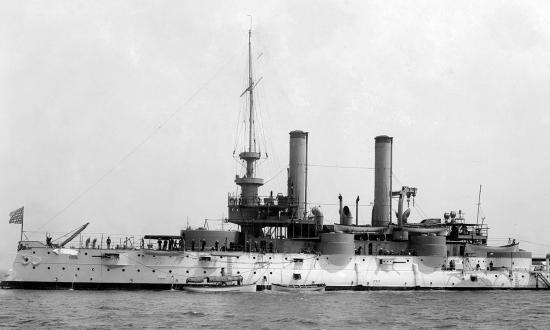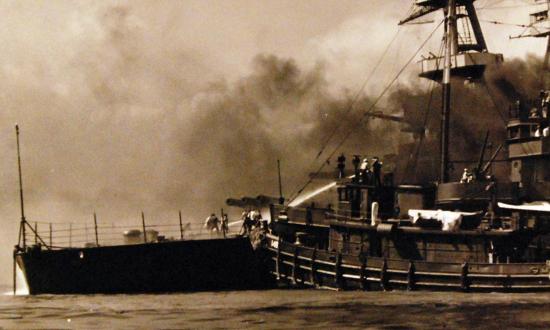When the coastal trading vessel Mastico sailed from Tripoli Harbor in North Africa in December 1803, her master set a course into the dangerous waters of the Mediterranean. Laden with passengers and a cargo that was part of Pasha Jousef Karamanli’s annual tribute to the Ottoman Court at Constantinople, the Mastico stayed in the coastal shallows, hoping to evade the American frigate Constitution and brig Enterprise as they cruised Tripoli’s approaches enforcing a blockade that had been initiated a few years earlier at the start of the Barbary War. Thus began a series of events that led to some of the U.S. Navy’s earliest triumphs and tragedies and the addition of the first Intrepid to a lineage of ships that would stretch across American naval heritage.
Conflict between the United States and the kingdoms and sultanates along Africa’s north coast had begun in the wake of the American Revolution. The capture of the American brigantine Betsy in 1784 was followed by more than a decade of threats, diplomacy, and economic coercion. But the First Barbary War began only when Pasha Karamanli decided the Americans were not paying him enough protection money, and, on 10 May 1801, he declared war on the United States by sending his troops into the courtyard of the U.S. consul’s house and cutting down the flagpole that held up the Stars and Stripes.
In 1801, Lieutenant Andrew Sterret and his brig the Enterprise captured the enemy warship Tripoli in the first ship-on-ship battle of the war. But by the autumn of 1803, the young U.S. Navy’s performance had been mixed, and little progress had been made toward a resolution. The United States partnered with the Swedish Navy and collaborated with others to establish the blockade of Tripoli and institute convoys to protect merchants. However, American merchant ships continued to be captured, and the blockade was not particularly effective at bottling up the Tripolitan marine.
In October 1803, the Tripolitans captured the frigate Philadelphia, taking more than 300 American sailors prisoner. At about the same time, Commodore Edward Preble took command of the Mediterranean Squadron, bringing a more aggressive attitude than that of his predecessors Richard Dale and Richard Valentine Morris. The Tripolitanian capture of the Philadelphia had nearly sunk the reputation of the U.S. Navy, and it presented Preble with a significant problem.
Bound for the Dardanelles, the Mastico sailed on 22 December 1803. Commodore Preble and his flagship Constitution had paired with the Enterprise, under Lieutenant Stephen Decatur, who took command after Sterret headed home a hero. The American ships spotted the Mastico on 23 December. The Enterprise, with a shallow draft and an aggressive skipper, rushed into the shallows to give chase. Flushed into deeper water, the ketch came under the massive broadside of Old Ironsides. Pinned between the two American warships, the Mastico’s crew surrendered to Preble. The ship was taken to the U.S. base at Syracuse on Sicily to be disposed of as a prize of war.
Intrepid’s First Mission
In early January, Decatur approached the commodore with a daring plan. Because the forces in Tripoli probably did not yet know that the Mastico was in American hands, Decatur believed the boat could serve as the perfect means to deal with the Philadelphia problem. He suggested loading the ship with a raiding force to slip into Tripoli Harbor and recapture the American frigate.
Preble agreed but thought it too dangerous to try to recapture the Philadelphia. Instead, he renamed the Mastico and ordered Decatur and a volunteer crew from the Constitution and Enterprise to take “Intrepid” into the harbor in the dark of night and destroy the captured frigate. With the brig Syren in company, the Intrepid sailed in February 1804.
The raiding force made a difficult passage from Sicily. The Intrepid’s crew discovered that much of its food was spoiled, and a late-winter storm hit them. Fighting an angry sea, the two ships became separated in the rain, and the Intrepid approached the enemy coast alone on 16 February.
Decatur held an all-officers meeting. With more storm clouds on the horizon, they collectively decided to launch their raid that evening rather than wait for the Syren to rejoin. As night fell, most of the armed sailors and Marines hid below while a skeleton crew sailed the ketch into the harbor.
The Intrepid ghosted through the ships anchored off the Pasha’s fortress. Claiming to have lost their anchor in the recent storm, the crew talked themselves close to the Philadelphia and proceeded to lash themselves alongside while their Sicilian pilot chatted with the guards. On Decatur’s signal, the sailors and Marines poured out of the hold and over the Philadelphia’s sides. With cutlasses and knives, they dispatched the guards in the quiet of the night, then began setting combustibles throughout the ship. With the fuses lit, the raiders were spotted, and the fortress began to fire on them. Decatur ordered his men back on board the Intrepid, following them as flames spread into the Philadelphia’s rigging.
Firing their four small cannon and small arms, they fought their way out of the harbor. The Intrepid escaped entirely unharmed, without a single American casualty. As the raiders reached the end of the channel, the Syren and her boats joined them, providing covering fire and ensuring all could escape. With storm clouds approaching, the Intrepid resupplied from the Syren’s stores, and the two ships prepared to weather another gale as they set course for Syracuse. They arrived safely to a hero’s welcome, and Stephen Decatur—just 25 years old—would soon be promoted to captain as a reward for his daring leadership. He remains the youngest officer ever promoted to the rank.
An Unmanned Attack
The February attack into Tripoli Harbor and the burning of the Philadelphia were a turning point. Preble doubled down on the momentum it generated and began planning to move beyond convoy operations and the blockade. As summer 1804 approached, the American squadron gathered, along with a flotilla of gunboats from the Kingdom of Naples under Preble’s command. At the end of July, Preble approached Tripoli with the Constitution, three brigs, three schooners, two bomb ketches, six gunboats, and the Intrepid. During repeated attacks on Tripoli that summer, the Intrepid served as a utility vessel carrying dispatches, functioning as a hospital ship, and making supply runs to help keep the squadron on station. It was not glorious work, but it was necessary.
When the bombardments failed to bring the Pasha to terms, Preble again turned to the Intrepid to carry out another daring idea. Tripoli Harbor’s long channel and depth had made it difficult for U.S. attacks to reach deep into the city. With Master Commandant Richard Somers placed in command, the Intrepid, was loaded with explosives and rigged as a fireship. Somers and a skeleton crew planned to maneuver the ship in the dark of night to position her in the channel, set the sails, lash the tiller, and then abandon ship. As the crew rowed away, the explosive-laden unmanned craft would sail herself across the harbor, crashing into the Pasha’s fortress walls and exploding.
On 4 September, Somers and the small crew headed for the harbor, with the schooners Argus, Vixen, and Nautilus along to soften up the defenses and protect the crew as it escaped. With favorable winds, Somers entered the channel as the schooners hove to and positioned themselves to fire on any counterattack. The Intrepid silently made her way down the channel with sails sheeted tight, while the schooner captains tried to track her with their night glasses.
Suddenly, the eerie quiet was rocked by a massive explosion. Far earlier than expected, the Intrepid erupted into a ball of fire. Preble later reported to the Secretary of the Navy that the night, for a moment, became as bright as day. Despite the fear the explosion provoked within the harbor and the city, the mission had failed. The cause of the Intrepid’s early detonation was never discovered, and Richard Somers and his crew were lost.
The converted merchant vessel had performed many of the small, unsung tasks of naval operations, served as a maritime raiding base, and ultimately was lost in an attempted unmanned surface attack. Today she is honored by her namesake Intrepid (the former CV-11), a museum ship in New York, one of three ships to carry on the name over the past two centuries.



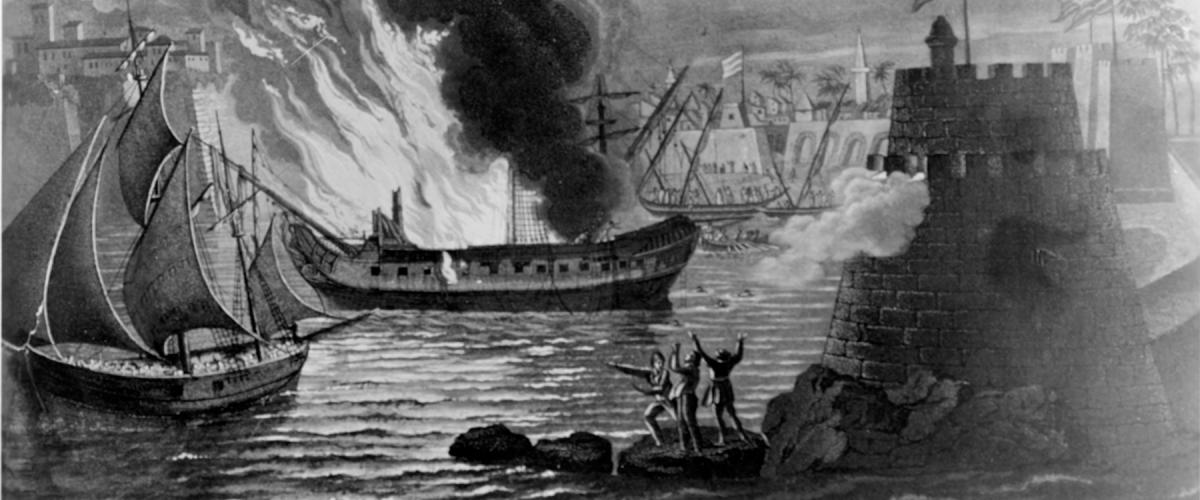
![On his contemporary sketch of the Intrepid, Midshipman William Lewis wrote, “The Ketch Intrepid taken by the Constitution of[f] Tripoli in Dec. 1803. Was the vessel with which Capt. Decatur burnt the Philadelphia in Feby 1804. She served as a store vessel off Tripoli and was at last turned into an Infernal [a fireship] in order to blow up part of the Bashaw’s castle.”](/sites/default/files/styles/embed_small/public/Historic%20Ships%20MJ24-1.jpg?itok=_-0mrswJ)
